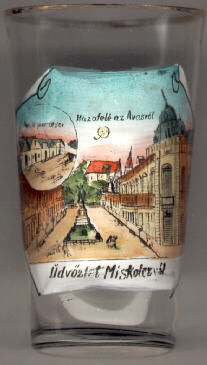

|
| MAGYARORSZÁG | HUNGARY |
| megye: Borsod-Abaúj-Szemplén |
Human settling in the area of Miskolc can be traced back for thousands of years.
Ice Age bones found in caves of the Bükk mountains are
considered one of the oldest traces of humans in Europe. The Hungarian tribe
by the name of the Bors (hence the name of the district Borsod) came into the area
in the 9th century. The oldest mentioning of Miskolc (terra Miskoucy)
in a document dates from ca. 1210. The town was looted by the Turks in 1544 and
was occupied by them from 1596 until 1687. As the town always supported the struggle
of the Hungarians for separation from the Habsburgs, it was burnt down by Imperial
troops in 1706. Iron-working industry began at the end of the 18th century using
ore from the Bükk mountains. Since the 19th century and especially since after
World War II Miskolc has become a major site of heavy industry.

The  Reformed church [centre back]
on the northern slope of the Avas hill was founded in the 13th century and
is the oldest building in Miskolc. The church was remodeled in gothic style between 1470 and 1490.
After being destroyed by a fire during the turkish attack of 1544 it was rebuilt between 1560 and 1569 by the
protestant congregation. The detached bell-tower dates from 1557 and is one
of the landmarks of Miskolc.
Reformed church [centre back]
on the northern slope of the Avas hill was founded in the 13th century and
is the oldest building in Miskolc. The church was remodeled in gothic style between 1470 and 1490.
After being destroyed by a fire during the turkish attack of 1544 it was rebuilt between 1560 and 1569 by the
protestant congregation. The detached bell-tower dates from 1557 and is one
of the landmarks of Miskolc.
Avas hill (243 m) is a popular place for excursions as it offers a splendid
view over the area. As Miskolc also is a wine-growing area, many
 wine-cellars
wine-cellars
In the centre of Szabadság tér ('Independence Square', formerly called Erzsébet tér, 'Elisabeth Square'),
the  monument
monument
![[scale]](lineal.jpg)